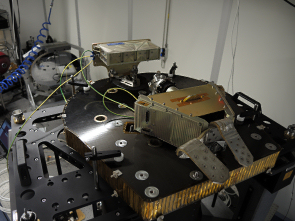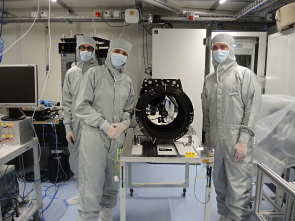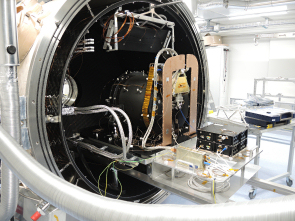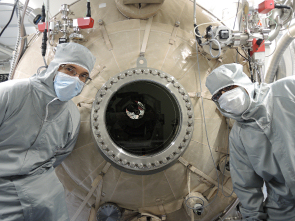#9: The CHEOPS scientific instrument is complete
6 December 2017
The scientific instrument at the heart of the CHEOPS mission has been fully assembled, marking an important milestone in the development of this small, fast-track exoplanet-characterising mission. |
| CHEOPS Focal Plane Module. Credit: University of Bern |
The Focal Plane Module (FPM), which houses the CCD detector array and the Front-End Electronics, was secured in place on the telescope assembly at the University of Bern this month, completing the construction of the ultra-high-precision photometer that will be used to measure, with high accuracy, the radii of planets orbiting nearby stars. This instrument will now be calibrated at Bern and later integrated with the spacecraft platform, which is currently undergoing final testing in Madrid at the premises of the prime contractor, Airbus Defence and Space–Spain (ASE).
The design and development of the CHEOPS instrument is the result of a pan-European endeavour that has drawn together experts from across the continent. The instrument structure was designed and manufactured in Switzerland, the optics came from Italy, the baffle from Belgium, the data processing unit and flight software from Austria, the radiators from Hungary, and the FPM, which was assembled in Germany, uses a CCD detector manufactured in the United Kingdom.
 |
| Engineers have been performing extensive tests with the CHEOPS telescope flight model in the ISO class 5 cleanroom at the University of Bern. Credit: University of Bern, T. Beck |
It has taken over four years of effort to get this far. The CHEOPS instrument consortium started work in mid-2013 and the manufacturing phase of the flight model began at the end of 2015. An intense period followed, during which the subsystems were manufactured and tested prior to shipment to the University of Bern for final integration.
Although the flight model of the FPM was integrated this month, preparations for its optical alignment have been taking place using a fully representative engineering model of the focal plane and the flight telescope, which became available last May. Alignment procedures have been rehearsed carefully and a test campaign under low-temperature, vacuum conditions has been carried out to ensure that the alignment performed in ambient conditions will give the expected result in orbit. To do this, the instrument was placed inside a vacuum chamber and illuminated from the outside, while the detector and the telescope tube were cooled to their operational temperatures of -40 °C and -10 °C, respectively. By accurately measuring how the shape and size of a star-like image changed as the instrument went from ambient conditions to cold operating conditions, it was possible to evaluate the accuracy of the in-orbit alignment.
 |
 |
| Testing the CHEOPS scientific instrument. Credit: University of Bern |
CHEOPS through the looking glass. Credit: University of Bern |
The precise optical alignment must also withstand the mechanical loads that will be experienced at launch. To verify this, the FPM engineering model integrated with the flight telescope was equipped with accelerometers and subjected to vibrational testing. The objectives of the vibration test were to verify the structural integrity of the instrument, to measure the structural response to sinusoidal and random excitation, and to determine the resonant frequencies of the instrument in the out-of-plane and in-plane directions between 5 Hertz and 2000 Hertz. Reassuringly, the instrument met all qualification criteria and, in particular, the alignment was confirmed to be preserved.
| CHEOPS vibration test. (Click here for details and large versions of the video.) Credit: NCCR PlanetS |
Once in orbit, CHEOPS will target bright stars that are known to host exoplanets. As the spacecraft changes attitude to point at each target star, sunlight will fall onto the instrument at different angles causing variations in the amount of heating it experiences. In September, thermal testing was performed to ensure that the temperature changes experienced by the CCD detector and the Front-End Electronics (FEE) will be within acceptable limits. The tests involved equipping the thermal vacuum chamber at the University of Bern with dedicated heaters to simulate parasitic heat flux from the Sun, and mounting a liquid nitrogen shroud in front of the instrument radiators to simulate the radiative sink temperature expected in space. The tests covered the extremes of the expected operational temperature range and investigated six different thermal balance cases, which were used to consolidate the mathematical thermal model of the instrument. The test results show that all units are able to stay within the allocated operational temperature ranges. Moreover, they provide a high level of confidence that, for all the available pointing attitudes, the stringent thermal stability requirements for the CCD and the Front-End Electronics (respectively 10 and 50 mK root mean square variation) will be met.
The instrument team is now entering the final stages of the verification campaign. The ElectroMagnetic Compatibility (EMC) acceptance test will be performed – (see CHEOPS journal #5 and journal #7 for details of previous EMC test campaigns). After this, the final vibration test at instrument level will be made to check workmanship, followed by a measurement to confirm that the alignment of the flight model FPM to the telescope has been maintained.
The final activity to be completed at the University of Bern will be the Instrument Calibration Campaign. Calibration is essential for characterising the detector and the flight electronics in terms of photo response non-uniformity, system gain, read-out noise, as well as the shape and variation of the point spread function over the field of view, and for verifying compliance with the instrument performance requirements. This information will be carefully reviewed and used in the processing of the scientific data that CHEOPS will collect once operational.
With calibration completed, the instrument will be shipped to the spacecraft prime contractor—Airbus Defence and Space–Spain (ASE)—for integration with the spacecraft platform, so that the overall satellite verification can be completed by the end of 2018.
The delivery of the instrument to the prime contractor will represent a key milestone for the CHEOPS project and is the result of a significant effort in a large number of European institutions.
About CHEOPS
CHEOPS is an ESA mission implemented in partnership with Switzerland, through the Swiss Space Office (SSO). The University of Bern leads a consortium of 11 ESA Member States contributing to the mission and represented in the CHEOPS Science Team. ESA is the mission architect responsible for overall mission definition and procurement of the spacecraft and launch. ESA is also responsible for the early operations phase that will be executed by the spacecraft contractor, Airbus Defence and Space–Spain (ASE). The science instrument is led by the University of Bern, with important contributions from Austria, Belgium, Germany and Italy. Other contributions to the science instrument, in the form of hardware or science operations, are provided by Hungary, France, Portugal, Sweden, and the United Kingdom. CHEOPS will be launched from Europe's spaceport in Kourou, French Guiana, on a Soyuz rocket operated by Arianespace. Following successful in-orbit commissioning of the spacecraft, responsibility for operations will be taken over by the CHEOPS Mission Consortium, with the Mission Operations Centre under the responsibility of INTA, Spain, and the Science Operations Centre led by the University of Geneva, Switzerland.





